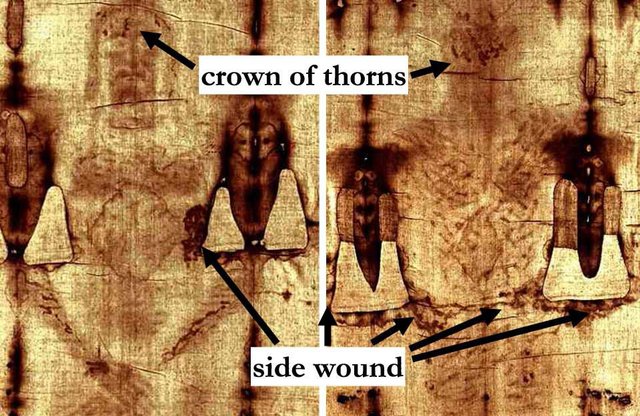Is this the face of Christ? The image on the Turin Shroud.
Photography was a hobby only for the dedicated in 1898. Secundo Pia, an Italian archaeologist, was a mere amateur. But the photograph he took in the Chapel of the Dukes of Savoy at Turin Cathedral was of profound significance to Christianity. For the negative that Pia produced appeared to show the face of Christ.
The young archaeologist was the first person to be allowed to photograph the cathedral's most famous relic, the Turin Shroud, in which Christ is reputed to have been wrapped after crucifixion. The shroud had always been said to bear the faint outlines of Christ's body - although the same claim has been made for 40 or more other pieces of linen preserved in various churches around Europe. But when Pia took his photograph, the result was a clear negative picture of a crucified man.
Because scientific photography was a relatively untried medium, Pia's remarkable picture was not at first universally accepted as genuine. It was not until 1931 that the shroud was again properly photographed, this time by a professional cameraman, Guiseppe Enri. And it was his remarkable picture which converted many of the skeptics, as well as prompting world-wide interest in the relic.
Nowadays, following years of scientific investigation, the Holy Shroud of Turin can be 'read' almost like a book. It tells a story that spans almost 2,000 years. The shroud is 14 ft long and 3,5 ft wide. It is made of a mixture of cotton and linen, woven into a regular herringbone pattern in the style common in Palestine during the 1st century AD.
Swiss scientists have even analyzed pollen in the cloth and dated it to the same period. The cream-colored material is marked by faint brown outline of a man's body, with darker rust-colored stains of blood. The marks indicate that the man was naked, 5 ft 11 tall and had shoulder-length hair and beard. It had also been clear that he had been tortured and crucified. The hands has been nailed through the palms and the feet had been fastened together buy a single nail. The strains indicate that the body had received more than 100 lash marks, many inflicted with a scourge - a flail with heavy metal balls attached - and that the man's side had been pierced by a spear.
It is easy to accept that blood would have stained the shroud, but it is not so simple to understand how the outline of the body could have been dyed into the fabric and remained for so many centuries. One popular explanation is that the resurrection caused a supernatural release of energy which scorched the linen. More scientific is the theory that the stains were caused by gas from the skin (probably ammonia) or sweat, mixed with ritual Jewish burial spices.
The most recent and most startling theory, however, is that put forward by US air Force scientists who believe that the image on the shroud was caused by a micro-second burst of intense radiation.
Much research was carried out to trace the journey of the shroud back to it's origins. The first reference to the Crucifixion shroud comes in St Mark's Gospel, which states that the cloth in which Christ was wrapped was found in his empty tomb. Three hundred years elapsed before the shroud was next mentioned in the reports of pilgrims to Jerusalem. The cloth found its way from Palestine to Constantinople, and from there to France, where it arrived in the 13th century.
In the late 15th century it was given for safe keeping to Louis I, who built a chapel at Chambery to house it. But in 1532 fire swept the chapel and damaged the silver casket in which the relic was kept. It is assumed that this was when the folded shroud acquired the symmetrical burn marks which disfigure it. The fabric was carefully mended by nuns was eventually moved to Turin Cathedral in 1572.
If the history of the shroud is so uncertain, why are so many Christians convinced that it represents the only true picture of Christ? Thousands of people were crucified by the Romans. Why single out this burial cloth as being that of Christ?
The answer has been provided by the scientists. They say that the imprint on the shroud indicates that the victim's hair was mattered with blood and that blood had coagulated in scratches across his forehead. It is evidence that talliers with Biblical stories of the crown of thorns thrust mockingly on the head of the 'King of the Jews'.
I hope you enjoyed the read, please follow me @virtashare for my next post. I am looking forward to all comments and feedback.
Cheers

Very interesting indeed,I love it when science and religion work together! I have re-posted this! Cheerz
Thanks for the re-post, it was a subject i did a little research on and found quite interesting, I figured I would share.
Pretty cool. I look at these things rather skeptically, but appreciate the possibilities.
I understand, I myself am not very religious and consider myself more spiritual rather. Thanks for reading
Oh, I'm a Christian. But these things tend to become items of worship and veneration. So, on a spiritual level, I tend to consider them meaningless.
However, on a historical or scientific level, maybe there's something there. I just don't know. Why this one shroud of all the thousands over the centuries? Are there others that exhibit this?
It may be genuine. It may not. There's no first hand testimony either way, and likely can't ever be. Even if someone found something supposedly written, it would still be suspect.
So, yeah, very fascinating. Pretty cool, actually. It can promote our imaginations. But I'd be slow to make more of it.
Thanks for your work on it. Well done.